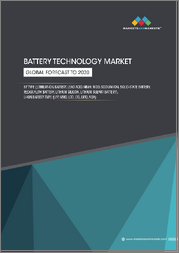
|
시장보고서
상품코드
1635790
선박용 리튬이온 배터리 시장 : 세계 산업 분석, 규모, 점유율, 성장, 동향, 예측(2025-2032년)Marine Lithium-ion Battery Market: Global Industry Analysis, Size, Share, Growth, Trends, and Forecast, 2025 - 2032 |
||||||
Persistence Market Research는 최근 세계 선박용 리튬이온 배터리 시장에 대한 통찰력 있는 보고서를 발표했습니다. 이 종합적인 연구는 주요 촉진요인, 동향, 과제 및 기회와 같은 시장 역학을 철저히 분석하여 2025년부터 2032년까지 시장의 성장 궤도에 대한 상세한 전망을 제공합니다.
주요 인사이트
- 선박용 리튬이온 배터리 시장 규모(2025년) : 3억 5,670만 달러
- 시장 예측 금액(2032년) : 10억 9,640만 달러
- 세계 시장 성장률(CAGR, 2025-2032년) : 17.40%
선박용 리튬이온 배터리 시장 - 조사 범위:
선박용 리튬이온 배터리(Li-ion Battery)는 전기 선박 및 하이브리드 선박을 위한 안정적이고 효율적인 에너지 저장 솔루션으로 각광받고 있습니다. 기존 납축배터리에 비해 에너지 밀도가 높고, 수명이 길고, 충전 시간이 짧기 때문에 선박용 리튬이온 배터리는 해운 업계에서 점점 더 널리 사용되고 있습니다. 이 배터리 시장은 주로 전기 보트 및 전기 선박의 채택 증가, 해상 배출량 감소에 대한 수요, 에너지 저장 솔루션의 개선 요구에 의해 주도되고 있습니다. 규제가 강화되고 해양 분야의 친환경 에너지 솔루션에 대한 수요가 증가함에 따라 해양 리튬이온 배터리는 업계의 미래에 중요한 역할을 할 것입니다.
시장 성장 촉진요인:
선박용 리튬이온 배터리 시장은 몇 가지 중요한 요인에 의해 주도되고 있습니다. 전기 선박 및 하이브리드 선박과 같은 친환경적이고 에너지 효율적인 운송에 대한 수요 증가가 큰 원동력이 되고 있습니다. 이러한 배터리는 온실 가스 배출과 연료 소비를 줄이는 데 도움이 되며, 지속가능성을 촉진하고 해운 업계의 엄격한 환경 규제를 충족하기 위한 전 세계적인 노력과 일치합니다. 에너지 밀도, 수명 및 효율성을 향상시키는 선박용 배터리 기술의 기술적 발전은 시장 성장을 더욱 촉진하고 있습니다. 또한, 녹색 기술에 대한 정부의 노력과 인센티브는 해상 운송에서 재생에너지로의 전환이 증가함에 따라 시장에 큰 성장 기회를 제공하고 있습니다.
시장 억제요인:
유망한 성장 전망에도 불구하고, 선박용 리튬이온 배터리 시장은 몇 가지 도전에 직면해 있습니다. 리튬이온 배터리의 높은 초기 비용, 특히 대규모 해상용 리튬이온 배터리의 높은 초기 비용은 많은 해상 사업자들에게 큰 투자로 작용하는 주요 장애물입니다. 또 다른 문제는 기존 연료에 비해 상대적으로 긴 충전 시간으로 인해 특정 선박의 운항 효율에 영향을 미칠 수 있다는 점입니다. 또한, 선박용 충전 인프라의 제한된 가용성과 리튬이온 배터리의 재활용에 대한 우려도 시장 성장에 걸림돌이 될 수 있습니다. 이러한 장애물을 극복하는 것은 해양 산업에서 리튬이온 배터리의 광범위한 채택을 위해 필수적입니다.
시장 기회:
선박용 리튬이온 배터리 시장은 몇 가지 새로운 트렌드와 기술 혁신에 의해 주도되는 기회로 가득 차 있습니다. 배터리 관리 시스템(BMS)의 발전과 함께 전기 보트 및 하이브리드 보트에 대한 수요가 증가하고 있으며, 이는 큰 성장 잠재력을 가지고 있습니다. 또한, 요트 및 레저용 선박과 같은 오프그리드 해양용 에너지 저장 솔루션 시장도 확대되고 있습니다. 급속 충전 기술의 지속적인 발전은 충전 인프라의 효율성을 높여 리튬이온 배터리의 채택을 더욱 촉진할 것으로 보입니다. 또한, 배터리 제조업체, 전기 선박 개발자, 재생에너지 공급업체 간의 전략적 제휴는 시장 범위를 확대하고 선박용 리튬이온 배터리의 상용화를 촉진하는 데 도움이 될 것입니다.
보고서가 답변하는 주요 질문
- 세계 선박용 리튬이온 배터리 시장의 성장을 촉진하는 주요 요인은 무엇인가?
- 선박용 리튬이온 배터리와 기존 납축배터리의 에너지 밀도, 비용, 환경 지속성 비교는?
- 전기선박과 하이브리드 선박에서 선박용 리튬이온 배터리의 주요 용도는 무엇인가?
- 선박용 리튬이온 배터리 시장의 주요 기업은 어디에 있으며, 시장 지위를 유지하기 위해 어떤 전략을 취하고 있는가?
- 선박용 리튬이온 배터리 시장의 미래를 형성할 것으로 예상되는 기술 발전과 혁신은 무엇인가?
목차
제1장 주요 요약
제2장 시장 개요
- 시장 범위와 정의
- 시장 역학
- 성장 촉진요인
- 성장 억제요인
- 기회
- 과제
- 주요 동향
- 유형 수명주기 분석
- 선박용 리튬이온 배터리 시장 : 밸류체인
- 원자재 공급업체 리스트
- 제조업체 리스트
- 판매대리점 리스트
- 용도 리스트
- 수익성 분석
- Porter’s Five Forces 분석
- 지정학적 긴장 : 시장에 대한 영향
- 거시경제 요인
- 세계의 부문별 전망
- 세계의 GDP 성장 전망
- 세계의 상부 시장 개요
- 예측요인 - 관련성과 영향
- 규제와 테크놀러지 상황
제3장 세계의 선박용 리튬이온 배터리 시장 전망 : 실적(2019-2023년)과 예측(2025-2032년)
- 주요 하이라이트
- 시장 수량(단위) 예측
- 시장 규모와 전년비 성장률
- 절대액 기회
- 시장 규모(백만 달러) 분석과 예측
- 과거 시장 규모 분석, 2019-2023년
- 현재 시장 규모 예측, 2025-2032년
- 세계의 선박용 리튬이온 배터리 시장 전망 : 유형
- 소개/주요 조사 결과
- 과거 시장 규모(백만 달러)와 수량(단위) 분석 : 유형별, 2019-2023년
- 현재 시장 규모(백만 달러)와 수량(단위) 예측 : 유형별, 2025-2032년
- 12 V
- 24 V
- 36 V
- 48 V
- 60 V
- 72 V
- 기타
- 시장 매력 분석 : 유형
- 세계의 선박용 리튬이온 배터리 시장 전망 : 용도
- 소개/주요 조사 결과
- 과거 시장 규모(백만 달러)와 수량(단위) 분석 : 용도별, 2019-2023년
- 현재 시장 규모(백만 달러)와 수량(단위) 예측 : 용도별, 2025-2032년
- 추진 시스템
- 보조 전원
- 비상용 전원 시스템
- 시장 매력 분석 : 용도
- 세계의 선박용 리튬이온 배터리 시장 전망 : 선박 유형
- 소개/주요 조사 결과
- 과거 시장 규모(백만 달러)와 수량(단위) 분석 : 선박 유형별, 2019-2023년
- 현재 시장 규모(백만 달러)와 수량(단위) 예측 : 선박 유형별, 2025-2032년
- 어선
- 호화 요트
- 화물선
- 군함
- 기타
- 시장 매력 분석 : 선박 유형
제4장 세계의 선박용 리튬이온 배터리 시장 전망 : 지역
- 주요 하이라이트
- 과거 시장 규모(백만 달러)와 수량(단위) 분석 : 지역별, 2019-2023년
- 현재 시장 규모(백만 달러)와 수량(단위) 예측 : 지역별, 2025-2032년
- 북미
- 유럽
- 동아시아
- 남아시아 및 오세아니아
- 라틴아메리카
- 중동 및 아프리카(MEA)
- 시장 매력 분석 : 지역
제5장 북미의 선박용 리튬이온 배터리 시장 전망 : 실적(2019-2023년)과 예측(2025-2032년)
제6장 유럽의 선박용 리튬이온 배터리 시장 전망 : 실적(2019-2023년)과 예측(2025-2032년)
제7장 동아시아의 선박용 리튬이온 배터리 시장 전망 : 실적(2019-2023년)과 예측(2025-2032년)
제8장 남아시아 및 오세아니아의 선박용 리튬이온 배터리 시장 전망 : 실적(2019-2023년)과 예측(2025-2032년)
제9장 라틴아메리카의 선박용 리튬이온 배터리 시장 전망 : 실적(2019-2023년)과 예측(2025-2032년)
제10장 중동 및 아프리카의 선박용 리튬이온 배터리 시장 전망 : 실적(2019-2023년)과 예측(2025-2032년)
제11장 경쟁 구도
- 시장 점유율 분석, 2024년
- 시장 구조
- 경쟁 강도 매핑 : 시장별
- 경쟁, 24 V
- 겉보기 제품 용량
- 기업 개요(상세 - 개요, 재무, 전략, 최근 동향)
- Corvus Energy
- Spear Power Systems
- EST-Floattech
- Forsee Power
- Akasol
- XALT Energy
- EVE Battery
- Saft
- Lithium Werks
- Gotion High-tech Co Ltd
- Toshiba Corporation
- Siemens
제12장 부록
- 조사 방법
- 조사 가정
- 두문자어와 약어
Persistence Market Research has recently published an insightful report on the global Marine Lithium-ion Battery Market. This comprehensive study provides a thorough analysis of the market dynamics, including key drivers, trends, challenges, and opportunities, offering a detailed outlook on the growth trajectory of the market from 2025 to 2032.
Key Insights:
- Marine Lithium-ion Battery Market Size (2025E): USD 356.7 Mn
- Projected Market Value (2032F): USD 1,096.4 Mn
- Global Market Growth Rate (CAGR 2025 to 2032): 17.40%
Marine Lithium-ion Battery Market - Report Scope:
Marine lithium-ion batteries (Li-ion batteries) are gaining momentum as a reliable and efficient energy storage solution for electric and hybrid marine vessels. With their higher energy density, longer life cycle, and faster charging times compared to conventional lead-acid batteries, marine lithium-ion batteries are becoming increasingly popular in the maritime industry. The market for these batteries is primarily driven by the growing adoption of electric boats and vessels, the demand for reducing maritime emissions, and the need for improved energy storage solutions. As regulations become stricter and the demand for green energy solutions in the maritime sector rises, marine lithium-ion batteries are poised to play a crucial role in the industry's future.
Market Growth Drivers:
The marine lithium-ion battery market is being driven by several key factors. The rising demand for eco-friendly and energy-efficient transportation, including electric and hybrid vessels, is a significant driver. These batteries help reduce greenhouse gas emissions and fuel consumption, aligning with global efforts to promote sustainability and meet stringent environmental regulations in the shipping industry. Technological advancements in marine battery technologies, which enhance energy density, lifespan, and efficiency, are further fueling market growth. Additionally, government initiatives and incentives for green technologies, coupled with the increasing shift toward renewable energy in marine transportation, are creating significant growth opportunities for the market.
Market Restraints:
Despite its promising growth prospects, the marine lithium-ion battery market faces several challenges. The high initial cost of lithium-ion batteries, especially for large-scale marine applications, is a key restraint, making it a significant investment for many marine operators. Another challenge is the relatively long charging time compared to conventional fuel sources, which may impact the operational efficiency of certain vessels. Moreover, the limited availability of charging infrastructure for marine vessels and concerns regarding the recycling of lithium-ion batteries may hinder market growth. Overcoming these obstacles will be essential for the widespread adoption of lithium-ion batteries in the maritime industry.
Market Opportunities:
The marine lithium-ion battery market is ripe with opportunities driven by several emerging trends and technological innovations. The increasing demand for electric and hybrid boats, along with advancements in battery management systems (BMS), presents significant growth prospects. There is also an expanding market for energy storage solutions for off-grid marine applications, such as yachts and recreational vessels. As advancements in fast-charging technologies continue, there will be a rise in the efficiency of charging infrastructure, further boosting the adoption of lithium-ion batteries. Moreover, strategic collaborations between battery manufacturers, electric vessel developers, and renewable energy providers will help expand market reach and enhance the commercialization of marine lithium-ion batteries.
Key Questions Answered in the Report:
- What are the key factors driving the growth of the marine lithium-ion battery market globally?
- How do marine lithium-ion batteries compare to traditional lead-acid batteries in terms of energy density, cost, and environmental sustainability?
- What are the major applications of marine lithium-ion batteries in electric and hybrid vessels?
- Who are the leading players in the marine lithium-ion battery market, and what strategies are they adopting to maintain their market position?
- What technological advancements and innovations are expected to shape the future of the marine lithium-ion battery market?
Competitive Intelligence and Business Strategy:
Leading players in the global marine lithium-ion battery market, including companies such as Saft, LG Chem, and BYD, are focusing on technological innovation, strategic collaborations, and expanding production capacity to strengthen their competitive positions. These companies are heavily investing in research and development to improve the performance and reduce the costs of marine lithium-ion batteries. Partnerships with electric vessel manufacturers, shipping companies, and renewable energy providers are key strategies being employed to expand market reach. By addressing challenges related to cost and charging infrastructure, these market leaders aim to position marine lithium-ion batteries as a viable and sustainable energy solution in the maritime industry.
Key Companies Profiled:
- Arkema Group
- BASF Petronas Chemicals Sdn. Bhd.
- Bax Chemicals
- DowDuPont, Inc.
- Eastman Chemical Company
- Evonik Industries AG
- ExxonMobil Chemical Company
- INEOS Group
- LG Chem Ltd.
- Oxea Corporation
Marine Lithium-ion Battery Market Research Segmentation
By Types:
- 12 V
- 24 V
- 36 V
- 48 V
- 60 V
- 72 V
By Application:
- Propulsion Systems
- Auxiliary Power
- Emergency Power Systems
- Lighting and Electronics
By Ship Type:
- Fishing Boats
- Luxury Yachts
- Cargo Ships
- Military Ships
By Region:
- North America
- Europe
- East Asia
- South Asia & Oceania
- Latin America
- Middle East & Africa
Table of Contents
1. Executive Summary
- 1.1. Global Marine Lithium-ion Battery Market Snapshot, 2025 - 2032
- 1.2. Market Opportunity Assessment, 2025 - 2032, US$ Mn
- 1.3. Key Market Trends
- 1.4. Future Market Projections
- 1.5. Premium Market Insights
- 1.6. Industry Developments and Key Market Events
- 1.7. PMR Analysis and Recommendations
2. Market Overview
- 2.1. Market Scope and Definition
- 2.2. Market Dynamics
- 2.2.1. Drivers
- 2.2.2. Restraints
- 2.2.3. Opportunity
- 2.2.4. Challenges
- 2.2.5. Key Trends
- 2.3. Type Lifecycle Analysis
- 2.4. Marine Lithium-ion Battery Market: Value Chain
- 2.4.1. List of Raw Material Supplier
- 2.4.2. List of Manufacturers
- 2.4.3. List of Distributors
- 2.4.4. List of Applications
- 2.4.5. Profitability Analysis
- 2.5. Porter Five Force's Analysis
- 2.6. Geopolitical Tensions: Market Impact
- 2.7. Macro-Economic Factors
- 2.7.1. Global Sectorial Outlook
- 2.7.2. Global GDP Growth Outlook
- 2.7.3. Global Parent Market Overview
- 2.8. Forecast Factors - Relevance and Impact
- 2.9. Regulatory and Technology Landscape
3. Global Marine Lithium-ion Battery Market Outlook: Historical (2019 - 2023) and Forecast (2025 - 2032)
- 3.1. Key Highlights
- 3.1.1. Market Volume (Units) Projections
- 3.1.2. Market Size and Y-o-Y Growth
- 3.1.3. Absolute $ Opportunity
- 3.2. Market Size (US$ Mn) Analysis and Forecast
- 3.2.1. Historical Market Size Analysis, 2019 - 2023
- 3.2.2. Current Market Size Forecast, 2025 - 2032
- 3.3. Global Marine Lithium-ion Battery Market Outlook: Type
- 3.3.1. Introduction / Key Findings
- 3.3.2. Historical Market Size (US$ Mn) and Volume (Units) Analysis By Type, 2019 - 2023
- 3.3.3. Current Market Size (US$ Mn) and Volume (Units) Forecast By Type, 2025 - 2032
- 3.3.3.1. 12 V
- 3.3.3.2. 24 V
- 3.3.3.3. 36 V
- 3.3.3.4. 48 V
- 3.3.3.5. 60 V
- 3.3.3.6. 72 V
- 3.3.3.7. Others
- 3.4. Market Attractiveness Analysis: Type
- 3.5. Global Marine Lithium-ion Battery Market Outlook: Application
- 3.5.1. Introduction / Key Findings
- 3.5.2. Historical Market Size (US$ Mn) and Volume (Units) Analysis By Application, 2019 - 2023
- 3.5.3. Current Market Size (US$ Mn) and Volume (Units) Forecast By Application, 2025 - 2032
- 3.5.3.1. Propulsion Systems
- 3.5.3.2. Auxiliary Power
- 3.5.3.3. Emergency Power Systems
- 3.6. Market Attractiveness Analysis: Application
- 3.7. Global Marine Lithium-ion Battery Market Outlook: Ship Type
- 3.7.1. Introduction / Key Findings
- 3.7.2. Historical Market Size (US$ Mn) and Volume (Units) Analysis By Ship Type, 2019 - 2023
- 3.7.3. Current Market Size (US$ Mn) and Volume (Units) Forecast By Ship Type, 2025 - 2032
- 3.7.3.1. Fishing Boats
- 3.7.3.2. Luxury yachts
- 3.7.3.3. Cargo ships
- 3.7.3.4. Military Ships
- 3.7.3.5. Others
- 3.8. Market Attractiveness Analysis: Ship Type
4. Global Marine Lithium-ion Battery Market Outlook: Region
- 4.1. Key Highlights
- 4.2. Historical Market Size (US$ Mn) and Volume (Units) Analysis By Region, 2019 - 2023
- 4.3. Current Market Size (US$ Mn) and Volume (Units) Forecast By Region, 2025 - 2032
- 4.3.1. North America
- 4.3.2. Europe
- 4.3.3. East Asia
- 4.3.4. South Asia and Oceania
- 4.3.5. Latin America
- 4.3.6. Middle East & Africa (MEA)
- 4.4. Market Attractiveness Analysis: Region
5. North America Marine Lithium-ion Battery Market Outlook: Historical (2019 - 2023) and Forecast (2025 - 2032)
- 5.1. Key Highlights
- 5.2. Pricing Analysis
- 5.3. Historical Market Size (US$ Mn) and Volume (Units) Analysis By Market, 2019 - 2023
- 5.3.1. By Country
- 5.3.2. By Type
- 5.3.3. By Application
- 5.3.4. By Ship Type
- 5.4. Current Market Size (US$ Mn) and Volume (Units) Forecast By Country, 2025 - 2032
- 5.4.1. U.S.
- 5.4.2. Canada
- 5.5. Current Market Size (US$ Mn) and Volume (Units) Forecast By Type, 2025 - 2032
- 5.5.1. 12 V
- 5.5.2. 24 V
- 5.5.3. 36 V
- 5.5.4. 48 V
- 5.5.5. 60 V
- 5.5.6. 72 V
- 5.5.7. Others
- 5.6. Current Market Size (US$ Mn) and Volume (Units) Forecast By Application, 2025 - 2032
- 5.6.1. Propulsion Systems
- 5.6.2. Auxiliary Power
- 5.6.3. Emergency Power Systems
- 5.6.4. Lighting and Electronics
- 5.7. Current Market Size (US$ Mn) and Volume (Units) Forecast By Ship Type, 2025 - 2032
- 5.7.1. Fishing Boats
- 5.7.2. Luxury yachts
- 5.7.3. Cargo ships
- 5.7.4. Military Ships
- 5.7.5. Others
- 5.8. Market Attractiveness Analysis
6. Europe Marine Lithium-ion Battery Market Outlook: Historical (2019 - 2023) and Forecast (2025 - 2032)
- 6.1. Key Highlights
- 6.2. Pricing Analysis
- 6.3. Historical Market Size (US$ Mn) and Volume (Units) Analysis By Market, 2019 - 2023
- 6.3.1. By Country
- 6.3.2. By Type
- 6.3.3. By Application
- 6.3.4. By Ship Type
- 6.4. Current Market Size (US$ Mn) and Volume (Units) Forecast By Country, 2025 - 2032
- 6.4.1. Germany
- 6.4.2. France
- 6.4.3. U.K.
- 6.4.4. Italy
- 6.4.5. Spain
- 6.4.6. Russia
- 6.4.7. Turkey
- 6.4.8. Rest of Europe
- 6.5. Current Market Size (US$ Mn) and Volume (Units) Forecast By Type, 2025 - 2032
- 6.5.1. 12 V
- 6.5.2. 24 V
- 6.5.3. 36 V
- 6.5.4. 48 V
- 6.5.5. 60 V
- 6.5.6. 72 V
- 6.5.7. Others
- 6.6. Current Market Size (US$ Mn) and Volume (Units) Forecast By Application, 2025 - 2032
- 6.6.1. Propulsion Systems
- 6.6.2. Auxiliary Power
- 6.6.3. Emergency Power Systems
- 6.6.4. Lighting and Electronics
- 6.7. Current Market Size (US$ Mn) and Volume (Units) Forecast By Ship Type, 2025 - 2032
- 6.7.1. Fishing Boats
- 6.7.2. Luxury yachts
- 6.7.3. Cargo ships
- 6.7.4. Military Ships
- 6.7.5. Others
- 6.8. Market Attractiveness Analysis
7. East Asia Marine Lithium-ion Battery Market Outlook: Historical (2019 - 2023) and Forecast (2025 - 2032)
- 7.1. Key Highlights
- 7.2. Pricing Analysis
- 7.3. Historical Market Size (US$ Mn) and Volume (Units) Analysis By Market, 2019 - 2023
- 7.3.1. By Country
- 7.3.2. By Type
- 7.3.3. By Application
- 7.3.4. By Ship Type
- 7.4. Current Market Size (US$ Mn) and Volume (Units) Forecast By Country, 2025 - 2032
- 7.4.1. China
- 7.4.2. Japan
- 7.4.3. South Korea
- 7.5. Current Market Size (US$ Mn) and Volume (Units) Forecast By Type, 2025 - 2032
- 7.5.1. 12 V
- 7.5.2. 24 V
- 7.5.3. 36 V
- 7.5.4. 48 V
- 7.5.5. 60 V
- 7.5.6. 72 V
- 7.5.7. Others
- 7.6. Current Market Size (US$ Mn) and Volume (Units) Forecast By Application, 2025 - 2032
- 7.6.1. Propulsion Systems
- 7.6.2. Auxiliary Power
- 7.6.3. Emergency Power Systems
- 7.6.4. Lighting and Electronics
- 7.7. Current Market Size (US$ Mn) and Volume (Units) Forecast By Ship Type, 2025 - 2032
- 7.7.1. Fishing Boats
- 7.7.2. Luxury yachts
- 7.7.3. Cargo ships
- 7.7.4. Military Ships
- 7.7.5. Others
- 7.8. Market Attractiveness Analysis
8. South Asia & Oceania Marine Lithium-ion Battery Market Outlook: Historical (2019 - 2023) and Forecast (2025 - 2032)
- 8.1. Key Highlights
- 8.2. Pricing Analysis
- 8.3. Historical Market Size (US$ Mn) and Volume (Units) Analysis By Market, 2019 - 2023
- 8.3.1. By Country
- 8.3.2. By Type
- 8.3.3. By Application
- 8.3.4. By Ship Type
- 8.4. Current Market Size (US$ Mn) and Volume (Units) Forecast By Country, 2025 - 2032
- 8.4.1. India
- 8.4.2. Southeast Asia
- 8.4.3. ANZ
- 8.4.4. Rest of South Asia & Oceania
- 8.5. Current Market Size (US$ Mn) and Volume (Units) Forecast By Type, 2025 - 2032
- 8.5.1. 12 V
- 8.5.2. 24 V
- 8.5.3. 36 V
- 8.5.4. 48 V
- 8.5.5. 60 V
- 8.5.6. 72 V
- 8.5.7. Others
- 8.6. Current Market Size (US$ Mn) and Volume (Units) Forecast By Application, 2025 - 2032
- 8.6.1. Propulsion Systems
- 8.6.2. Auxiliary Power
- 8.6.3. Emergency Power Systems
- 8.6.4. Lighting and Electronics
- 8.7. Current Market Size (US$ Mn) and Volume (Units) Forecast By Ship Type, 2025 - 2032
- 8.7.1. Fishing Boats
- 8.7.2. Luxury yachts
- 8.7.3. Cargo ships
- 8.7.4. Military Ships
- 8.7.5. Others
- 8.8. Market Attractiveness Analysis
9. Latin America Marine Lithium-ion Battery Market Outlook: Historical (2019 - 2023) and Forecast (2025 - 2032)
- 9.1. Key Highlights
- 9.2. Pricing Analysis
- 9.3. Historical Market Size (US$ Mn) and Volume (Units) Analysis By Market, 2019 - 2023
- 9.3.1. By Country
- 9.3.2. By Type
- 9.3.3. By Application
- 9.3.4. By Ship Type
- 9.4. Current Market Size (US$ Mn) and Volume (Units) Forecast By Country, 2025 - 2032
- 9.4.1. Brazil
- 9.4.2. Mexico
- 9.4.3. Rest of Latin America
- 9.5. Current Market Size (US$ Mn) and Volume (Units) Forecast By Type, 2025 - 2032
- 9.5.1. 12 V
- 9.5.2. 24 V
- 9.5.3. 36 V
- 9.5.4. 48 V
- 9.5.5. 60 V
- 9.5.6. 72 V
- 9.5.7. Others
- 9.6. Current Market Size (US$ Mn) and Volume (Units) Forecast By Application, 2025 - 2032
- 9.6.1. Propulsion Systems
- 9.6.2. Auxiliary Power
- 9.6.3. Emergency Power Systems
- 9.6.4. Lighting and Electronics
- 9.7. Current Market Size (US$ Mn) and Volume (Units) Forecast By Ship Type, 2025 - 2032
- 9.7.1. Fishing Boats
- 9.7.2. Luxury yachts
- 9.7.3. Cargo ships
- 9.7.4. Military Ships
- 9.7.5. Others
- 9.8. Market Attractiveness Analysis
10. Middle East & Africa Marine Lithium-ion Battery Market Outlook: Historical (2019 - 2023) and Forecast (2025 - 2032)
- 10.1. Key Highlights
- 10.2. Pricing Analysis
- 10.3. Historical Market Size (US$ Mn) and Volume (Units) Analysis By Market, 2019 - 2023
- 10.3.1. By Country
- 10.3.2. By Type
- 10.3.3. By Application
- 10.3.4. By Ship Type
- 10.4. Current Market Size (US$ Mn) and Volume (Units) Forecast By Country, 2025 - 2032
- 10.4.1. GCC
- 10.4.2. Egypt
- 10.4.3. South Africa
- 10.4.4. Northern Africa
- 10.4.5. Rest of Middle East & Africa
- 10.5. Current Market Size (US$ Mn) and Volume (Units) Forecast By Type, 2025 - 2032
- 10.5.1. 12 V
- 10.5.2. 24 V
- 10.5.3. 36 V
- 10.5.4. 48 V
- 10.5.5. 60 V
- 10.5.6. 72 V
- 10.5.7. Others
- 10.6. Current Market Size (US$ Mn) and Volume (Units) Forecast By Application, 2025 - 2032
- 10.6.1. Propulsion Systems
- 10.6.2. Auxiliary Power
- 10.6.3. Emergency Power Systems
- 10.6.4. Lighting and Electronics
- 10.7. Current Market Size (US$ Mn) and Volume (Units) Forecast By Ship Type, 2025 - 2032
- 10.7.1. Fishing Boats
- 10.7.2. Luxury yachts
- 10.7.3. Cargo ships
- 10.7.4. Military Ships
- 10.7.5. Others
- 10.8. Market Attractiveness Analysis
11. Competition Landscape
- 11.1. Market Share Analysis, 2024
- 11.2. Market Structure
- 11.2.1. Competition Intensity Mapping By Market
- 11.2.2. Competition 24 V
- 11.2.3. Apparent Product Capacity
- 11.3. Company Profiles (Details - Overview, Financials, Strategy, Recent Developments)
- 11.3.1. Corvus Energy
- 11.3.1.1. Overview
- 11.3.1.2. Segments and Product
- 11.3.1.3. Key Financials
- 11.3.1.4. Market Developments
- 11.3.1.5. Market Strategy
- 11.3.2. Spear Power Systems
- 11.3.2.1. Overview
- 11.3.2.2. Segments and Product
- 11.3.2.3. Key Financials
- 11.3.2.4. Market Developments
- 11.3.2.5. Market Strategy
- 11.3.3. EST-Floattech
- 11.3.3.1. Overview
- 11.3.3.2. Segments and Product
- 11.3.3.3. Key Financials
- 11.3.3.4. Market Developments
- 11.3.3.5. Market Strategy
- 11.3.4. Forsee Power
- 11.3.4.1. Overview
- 11.3.4.2. Segments and Product
- 11.3.4.3. Key Financials
- 11.3.4.4. Market Developments
- 11.3.4.5. Market Strategy
- 11.3.5. Akasol
- 11.3.5.1. Overview
- 11.3.5.2. Segments and Product
- 11.3.5.3. Key Financials
- 11.3.5.4. Market Developments
- 11.3.5.5. Market Strategy
- 11.3.6. XALT Energy
- 11.3.6.1. Overview
- 11.3.6.2. Segments and Product
- 11.3.6.3. Key Financials
- 11.3.6.4. Market Developments
- 11.3.6.5. Market Strategy
- 11.3.7. EVE Battery
- 11.3.7.1. Overview
- 11.3.7.2. Segments and Product
- 11.3.7.3. Key Financials
- 11.3.7.4. Market Developments
- 11.3.7.5. Market Strategy
- 11.3.8. Saft
- 11.3.8.1. Overview
- 11.3.8.2. Segments and Product
- 11.3.8.3. Key Financials
- 11.3.8.4. Market Developments
- 11.3.8.5. Market Strategy
- 11.3.9. Lithium Werks
- 11.3.9.1. Overview
- 11.3.9.2. Segments and Product
- 11.3.9.3. Key Financials
- 11.3.9.4. Market Developments
- 11.3.9.5. Market Strategy
- 11.3.10. Gotion High-tech Co Ltd
- 11.3.10.1. Overview
- 11.3.10.2. Segments and Product
- 11.3.10.3. Key Financials
- 11.3.10.4. Market Developments
- 11.3.10.5. Market Strategy
- 11.3.11. Toshiba Corporation
- 11.3.11.1. Overview
- 11.3.11.2. Segments and Product
- 11.3.11.3. Key Financials
- 11.3.11.4. Market Developments
- 11.3.11.5. Market Strategy
- 11.3.12. Siemens
- 11.3.12.1. Overview
- 11.3.12.2. Segments and Product
- 11.3.12.3. Key Financials
- 11.3.12.4. Market Developments
- 11.3.12.5. Market Strategy
- 11.3.1. Corvus Energy
12. Appendix
- 12.1. Research Methodology
- 12.2. Research Assumptions
- 12.3. Acronyms and Abbreviations



















